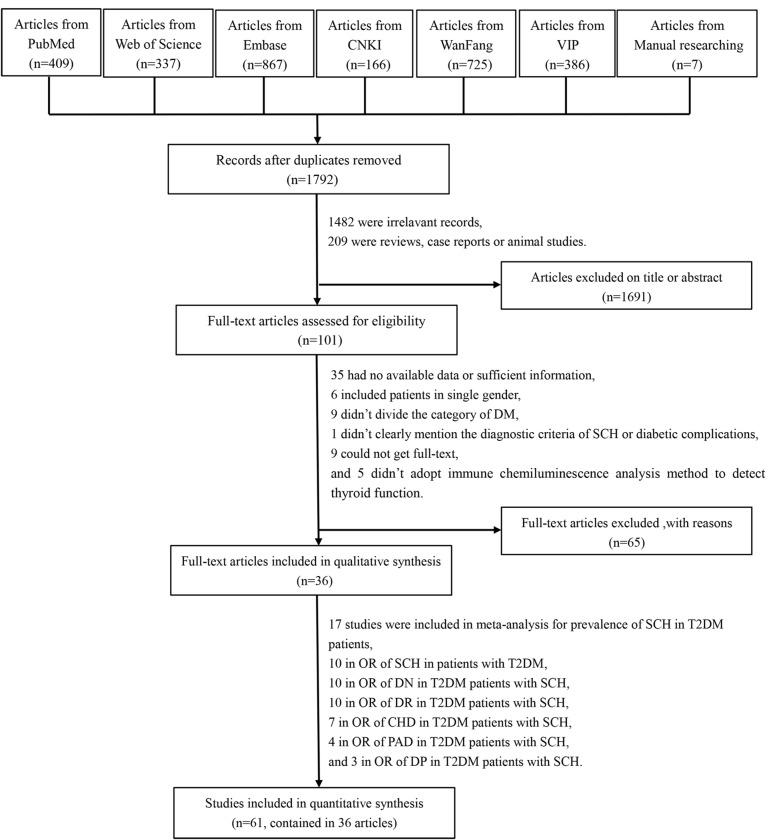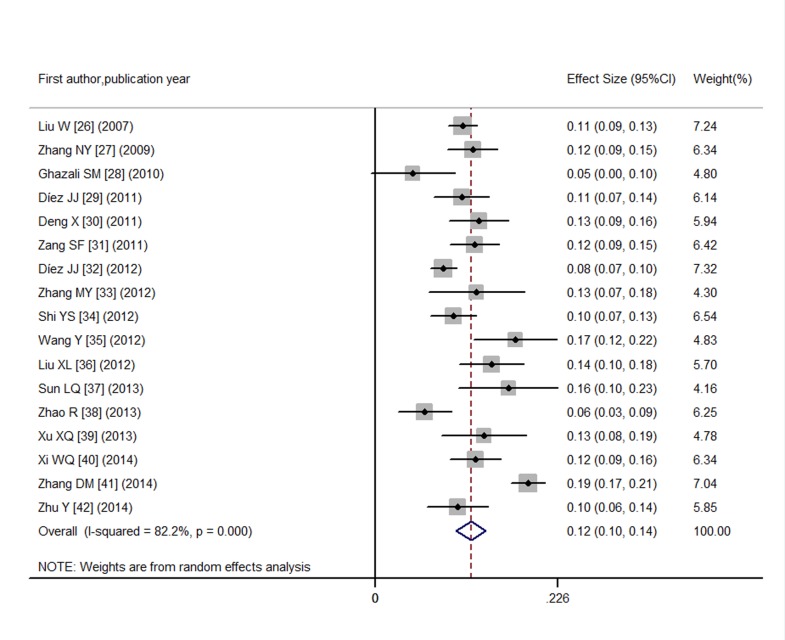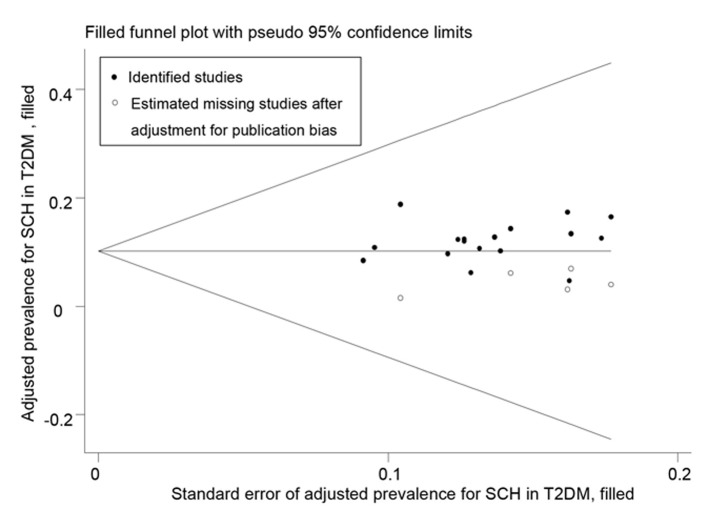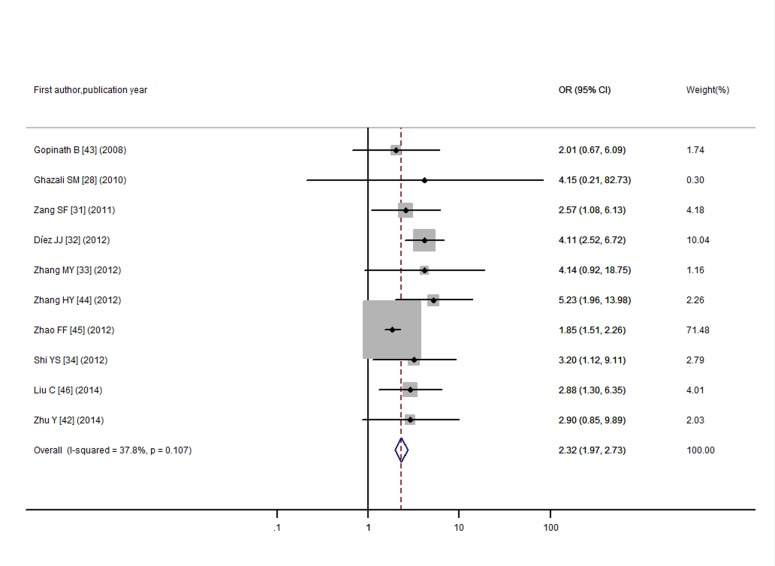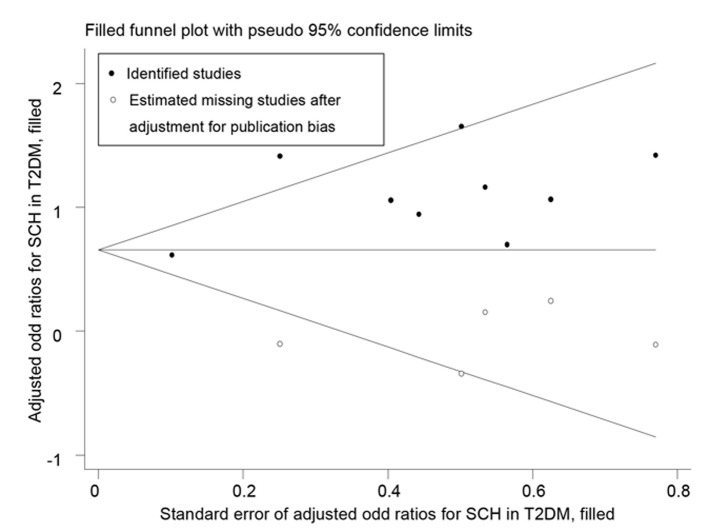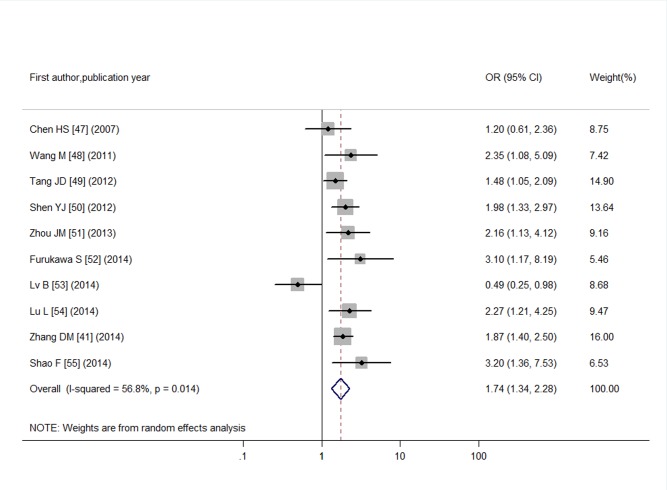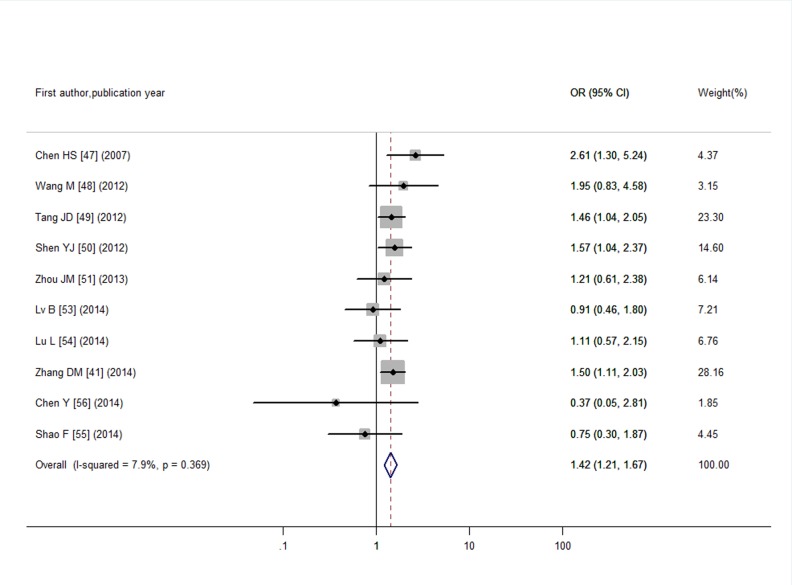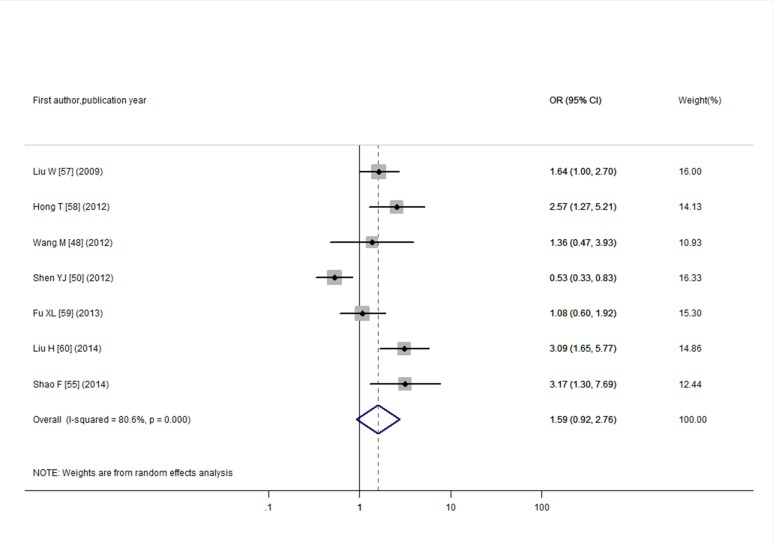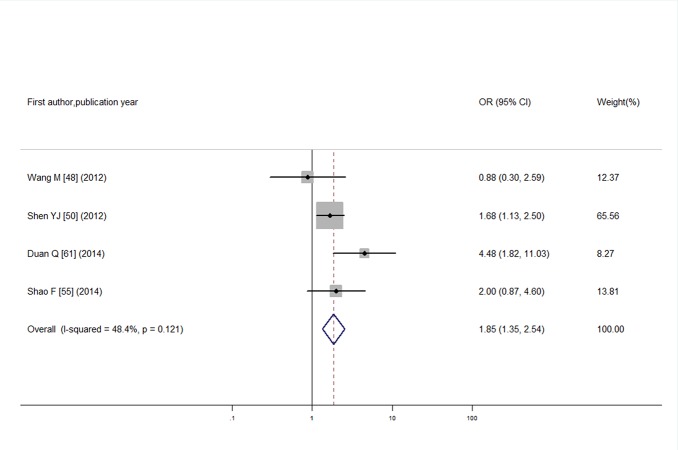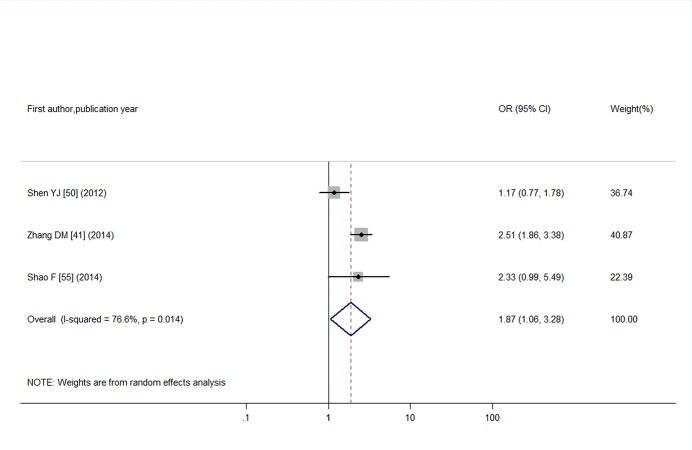Abstract
Background
Abundant evidence suggests an association between subclinical hypothyroidism (SCH) and type 2 diabetes mellitus (T2DM), but small sample sizes and inconclusive data in the literature complicate this assertion.
Objective
We measured the prevalence of SCH in T2DM population, and investigated whether T2DM increase the risk of SCH and whether SCH was associated with diabetic complications.
METHODS
We conducted a meta-analysis using PubMed, EMBASE, Web of Science, Wan Fang, CNKI and VIP databases for literature search. We obtained studies published between January 1, 1980 to December 1, 2014. The studies were selected to evaluate the prevalence of SCH in T2DM subjects, compare the prevalence of SCH in T2DM subjects with those non-diabetics, and investigate whether diabetic complications were more prevalent in SCH than those who were euthyroid. Fixed and random effects meta-analysis models were used, and the outcome was presented as a pooled prevalence with 95% confidence interval (95% CI) or a summary odds ratio (OR) with 95% CI.
RESULTS
Through literature search, 36 articles met the inclusion criteria and these articles contained a total of 61 studies. Funnel plots and Egger’s tests showed no publication bias in our studies, except for the pooled prevalence of SCH in T2DM (P = 0.08) and OR for SCH in T2DM (P = 0.04). Trim and fill method was used to correct the results and five potential missing data were replaced respectively. The adjusted pooled prevalence of SCH in T2DM patients was 10.2%, meanwhile, T2DM was associated with a 1.93-fold increase in risk of SCH (95% CI: 1.66, 2.24). Furthermore, SCH might affect the development of diabetic complications with an overall OR of 1.74 (95% CI: 1.34, 2.28) for diabetic nephropathy, 1.42 (95% CI: 1.21, 1.67) for diabetic retinopathy, 1.85 (95% CI: 1.35, 2.54) for peripheral arterial disease, and 1.87 (95% CI: 1.06, 3.28) for diabetic peripheral neuropathy.
Conclusions
T2DM patients are more likely to have SCH when compared with healthy population and SCH may be associated with increased diabetic complications. It is necessary to screen thyroid function in patients with T2DM, and appropriate individualized treatments in addition to thyroid function test should be given to T2DM patients with SCH as well.
Introduction
Diabetes is the most common chronic endocrine disease characterized by hyperglycemia resulted from impaired insulin secretion and/or insulin action [1]. Chronic diabetic hyperglycemia is associated with long-term organ damage, dysfunction and failure. Complications, such as vision loss, renal failure and cardiovascular diseases, are often outcomes of diabetes [2–4]. As the population ages and obesity increases, diabetes will increase as well. The global prevalence is predicted to be 11.1% in 2033, affecting 600 million people [5]. China is the world's most populous country, and data from the National Diabetes Prevalence Survey carried out from 2007 to 2008 revealed a prevalence of diabetes in Chinese adults to be 9.7% [6]. Thus, diabetes has reached epidemic proportions worldwide, and this burdens healthcare services and increases healthcare costs [7].
Numerous epidemiological studies indicate the higher prevalence of overt hypothyroidism in type 2 diabetes mellitus (T2DM) population than in the general population[8, 9]. However, the relationship between subclinical hypothyroidism (SCH) and T2DM is controversial. SCH, the slight hypothyroidism state, is asymptomatic but mild elevations in thyroid-stimulating hormone (TSH) with normal circulating free thyroid hormone concentrations are observed [10]. Numerous studies suggest that SCH is associated with hypertension, high cholesterol, and abnormal homocysteine level and patients with SCH have a higher risk of metabolic syndrome, atherosclerosis, cardiovascular events, and mortality [11–13]. Presently, controversy persists about indications for treatment of SCH and whether individuals should be routinely screened for this dysfunction [14, 15].
The guidelines of the American Thyroid Association (ATA) and the European Thyroid Association (ETA) recommend screening thyroid function in patients with Type 1 diabetes annually[16, 17]. However, there is lack of definitive guidance, local policies and/or practices focused on the screening of thyroid dysfunction in T2DM. Furthermore, despite of data suggesting a relationship between T2DM and SCH, conclusions are inconsistent and sample sizes are small. Thus, to investigate the association between SCH and T2DM, and to understand any role of SCH has on diabetic complications, we performed a systematic review and meta-analysis to present a pooled prevalence level of SCH in T2DM patients and to assess the diabetic complications risk in T2DM individuals with SCH.
Materials and Methods
Search strategy
In order to find relating articles on prevalence of SCH in T2DM subjects, and articles regarding the prevalence of complications in T2DM patients with SCH, we searched for English articles online using PubMed, EMBASE, and Web of Science. For all the Chinese articles, we searched online using the Chinese National Knowledge Infrastructure (CNKI), Chinese Wanfang and Chongqing VIP databases. All articles were published from January 1, 1980 to December 1, 2014. We adopted the following search strategies: 1. ((((((hypothyroidism [Title/Abstract]) OR TSH [Title/Abstract]) OR thyrotropin [Title/Abstract]) OR thyroid stimulating hormone [Title/Abstract])) AND ((diabetes [Title/Abstract]) OR hyperglycemia [Title/Abstract])) AND prevalence[Title/Abstract]; 2. (((((hypothyroidism [Title/Abstract]) OR TSH[Title/Abstract]) OR thyrotropin [Title/Abstract]) OR thyroid stimulating hormone[Title/Abstract])) AND diabetic complication [Title/Abstract]. To avoid overlooking any relevant study, we also scanned relevant reference lists and reviews to find additional studies. We attempted to contact the authors of the identified papers for necessary data not given in the original texts. Our study was conducted in adherence to the Preferred Reporting Items for Systematic Reviews and Meta-Analyses guidelines (PRISMA) [18], as shown in S1 Checklist.
Study selection
The study inclusion criteria were: (1) The design of the study had to be observational; (2) All the subjects involved were either T2DM individuals who had been evaluated for thyroid function, or individuals with/without SCH and were enrolled in a clinical and/or laboratory evaluation for diabetic complications;(3) outcome of interest was SCH prevalence in T2DM patients or the prevalence of diabetic complications in T2DM patients with SCH; (4) studies had adequate information for a pooled prevalence or odds ratio analysis; (5) when results obtained from the same population was reported in more than one articles, the most detailed report was included.
On the contrary, studies were excluded if they: (1) were case reports, letters, reviews, editorials, or expert opinions; (2) lacked necessary information such as age and year of study;(3) involved subjects that were pregnant or had chronic renal insufficiency; (4) included diabetics who had type 1 diabetes or unspecified conditions; (5) did not clearly mention the diagnostic criteria of SCH or diabetic complications; (6) included single-gender diabetics;(7) did not use immunochemiluminescent assay(ICMA) as laboratory detection method for thyroid function.
Data extraction and quality assessment
Two investigators independently conducted the systematic literature search, study selection, data extraction, and quality assessment. Discrepancies were resolved through discussion and consensus between the two investigators. For all included studies, data on the first author’s name, publication year, study year, age, location, the prevalence of SCH in T2DM or non-diabetics, and the prevalence of diabetic complications in SCH patients or euthyroid subjects were extracted.
As reported previously, in order to describe the quality of the researches that were incorporated in our meta-analysis, and to evaluate risk of bias in relation to methodological quality, we assessed the quality of observational researches[19]. The methodological quality of observational case-control studies were appraised by the Newcastle-Ottawa Scale (NOS) [20], and the cross-sectional studies were assessed using the evaluation criteria recommended by Agency for Healthcare Research and Quality (AHRQ) by 2 reviewers as mentioned previously[21].
Statistical analysis
All analyses were performed using STATA software, version 11.0 (Stata Corp LP, TX). We computed prevalence according to measurements reported previously [22, 23]. Prevalence for SCH in patients with T2DM was estimated as a total number of cases with SCH divided by the number of total patient with T2DM and was reported with 95% confidence interval (95% CI). We then performed a meta-analysis to assess the degree of correlation between T2DM and SCH risk expressed as odds ratio (OR) and 95% CI. Moreover, other meta-analyses were performed to evaluate the risk of diabetic complications in T2DM patients with SCH with ORs and 95% CIs. Heterogeneity among studies was measured with the I2 index and P value as previously[22]. I2 index of 25, 50 and 75% were each considered to be low, moderate and high levels of heterogeneity, respectively. For heterogeneity at moderate or high level, we adopted a random-effects meta-analysis instead of using a fixed-effects model [24]. If any moderate or high heterogeneity existed, we subsequently conducted a subgroup analysis to explore the source of the heterogeneity. Next, we examined publication bias by visual interpretation for funnel plot asymmetry and Egger's test [25]. For Egger’s test, P < 0.1 was considered to be statistically significant. Trim and fill analysis was applied if there was publication bias. For other analyses, P < 0.05 was considered to be statistically significant.
Results
Description of studies
We identified 2897 citations in the primary search with 1792 records remained after duplicates were removed. Title and abstract screening removed 1691 studies, and 101 full articles were reviewed for potential relevance. These articles were screened based on the inclusion and exclusion criteria for the study. Finally, 36 articles containing 61 independent studies met our eligibility criteria. In our study, most of the included articles contributed to at least one meta-analysis. Of the 36 articles included, 17 studies assessed the prevalence of SCH in T2DM patients of different sexes [26–42], and 10 studies compared the prevalence of SCH in T2DM patients with non-diabetic patients [28, 31–34, 42–46]. Another 34 studies computed the risk of suffering from diabetic complications for T2DM individuals with SCH, 10 studies for diabetic nephropathy (DN)[41, 47–55], 10 studies for diabetic retinopathy (DR)[41, 47–51, 53–56], 7 studies for coronary heart disease (CHD)[48, 50, 55, 57–60], 4 studies for peripheral arterial disease (PAD)[48, 50, 55, 61], and 3 studies for diabetic peripheral neuropathy (DPN)[41, 50, 55].This detailed selection process is shown in Fig 1.
Fig 1. Flow diagram of literature search.
Study characteristics of the published studies that investigate the prevalence of SCH in T2DM patients are shown in Table 1. Features of researches comparing the possibility of SCH in T2DM subjects with non-T2DM are shown in Table 2. Next, information about the studies assessing the relationship between diabetic complications and SCH is shown in Table 3.
Table 1. Characteristics of the studies included in the meta-analysis for the summarized prevalence of SCH in T2DM patients.
| First Author | Publication year | Area | Mean age a | Case(n) | Total(n) | Prevalence (%) | TSH | Research type | Score |
|---|---|---|---|---|---|---|---|---|---|
| Liu W [26] | 2007 | Beijing | 59.3±14 | 127 | 1170 | 10.85 | >4.0 mIU/L | CSS | 5 |
| Zhang NY [27] | 2009 | Jiangsu | 60.4 | 50 | 416 | 12.02 | >4.5 mIU/L | CSS | 5 |
| Ghazali SM [28] | 2010 | Nigeria | 50.1±18.9 | 3 | 64 | 4.69 | >4.31mIU/L | CC | 4 |
| Díez JJ [29] b | 2011 | Spain | F64.9±11, M62.2±11.2 | 34 | 318 | 10.69 | >5.0 mIU/L | CSS | 6 |
| Deng X [30] | 2011 | Wujiaqu, Xinjiang | 65 | 41 | 320 | 12.81 | >4.5 mIU/L | CC | 4 |
| Zang SF [31] | 2011 | Hangzhou, Zhejiang | 73.3±7.92 | 56 | 455 | 12.31 | >4.94mIU/L | CC | 3 |
| Díez JJ [32] | 2012 | Spain | 66.7±12 | 94 | 1112 | 8.45 | >4.2 mIU/L | CC | 6 |
| Zhang MY [33] | 2012 | Nanchang, Jiangxi | 56.3 | 15 | 120 | 12.5 | >5.0 mIU/L | CC | 3 |
| Shi YS [34] | 2012 | Shenyang, Liaoning | 55.5 | 40 | 413 | 9.69 | >4.5 mIU/L | CSS | 3 |
| Wang Y [35] | 2012 | Xi’ an, Shanxi | 60.4 | 36 | 208 | 17.31 | >4.20mIU/L | CC | 6 |
| Liu XL [36] | 2012 | Xinyi, Guangdong | 49.7±9.8 | 43 | 300 | 14.33 | >5.0 mIU/L | CC | 4 |
| Sun LQ [37] | 2013 | Fuyang, Zhejiang | 59.0 ± 7 | 23 | 140 | 16.43 | >5.5 mIU/L | CC | 5 |
| Zhao R [38] | 2013 | Yinchuan, Ningxia | 58±12 | 13 | 211 | 6.16 | >4.20mIU/L | CSS | 5 |
| Xu XQ [39] | 2013 | Hefei, Anhui | 46.35±11.93 | 22 | 164 | 13.41 | >4.2 mIU/L | CSS | 6 |
| Xi WQ [40] | 2014 | Hohhot, Inner Mongolia | 54.2±9.6 | 53 | 427 | 12.41 | >4.2 mIU/L | CSS | 5 |
| Zhang DM [41] b | 2014 | Changsha, Hunan | C63,S60 | 244 | 1294 | 18.86 | >5.6 mIU/L | CC | 4 |
| Zhu Y [42] | 2014 | Zhangjiagang, Jiangsu | 61 | 25 | 246 | 10.16 | >4.0 mIU/L | CC | 4 |
| In total | 919 | 7378 | 10.2 c |
a, Mean ages were expressed in mean ± SD or mean.
b, These original articles did not provide the mean age of the total population, so age data was extracted according to the age characteristics mentioned in the articles included.
c, adjusted pooled prevalence.
Abbreviation: F, female; M, male; C, subjects without SCH; S, subjects with SCH; TSH, thyroid stimulating hormone; CC, case control study; CSS, cross-sectional study.
Table 2. Characteristics of the studies included in the meta-analysis for comparing the possibility of SCH in T2DM subjects and non-T2DM.
| First author | Publication year | Area | Mean age | T2DM (n) | Non-T2DM(n) | TSH | Research type | Score | |||
|---|---|---|---|---|---|---|---|---|---|---|---|
| T2DM | Non-T2DM | Case | Total | Case | Total | ||||||
| Gopinath B [43] | 2008 | Australia | 68.8±7 | 67.6±7.6 | 4 | 113 | 17 | 950 | >4.0 mIU/L | CC | 5 |
| Ghazali SM [28] | 2010 | Nigeria | 50.1±18.9 | 53.8±24 | 3 | 64 | 0 | 36 | >4.31mIU/L | CC | 4 |
| Zang SF [31] | 2011 | Hangzhou, Zhejiang | 73.3±7.92 | 72.22±7.03 | 56 | 455 | 6 | 116 | >4.94mIU/L | CC | 3 |
| Díez JJ [32] | 2012 | Spain | 57.4 ± 16.1 | 66.7±12 | 94 | 1112 | 20 | 911 | >5.0 mIU/l | CC | 6 |
| Zhang MY [33] | 2012 | Nanchang, Jiangxi | 56.3 | 54.2 | 15 | 120 | 2 | 60 | >4.2 mIU/L | CC | 3 |
| Zhang HY [44] | 2012 | Tianjin | 57.7 | 58.9 | 26 | 180 | 5 | 160 | >5.0 mIU/L | CC | 3 |
| Zhao FF [45] | 2012 | Qingdao, Shandong | 60±12 | 60±12 | 250 | 2875 | 177 | 3612 | >4.2 mIU/l | CC | 3 |
| Shi YS [34] | 2012 | Shenyang, Liaoning | 55.5 | 54.3 | 41 | 413 | 4 | 120 | >5.0 mIU/L | CSS | 3 |
| Liu C [46] | 2014 | Changsha, Hunan | 60.4±10.5 | 61.5±9.3 | 25 | 190 | 9 | 180 | >4.2 mIU/L | CC | 3 |
| Zhu Y [42] | 2014 | Zhangjiagang, Jiangsu | 61 | 59.5 | 25 | 246 | 3 | 80 | >5.6 mIU/L | CC | 4 |
| In total a | 539 | 5768 | 243 | 6225 | |||||||
a, the adjusted pooled OR for SCH in T2DM was 1.93(95%CI: 1.66, 2.24).
Table 3. Characteristics of the studies included in the meta-analysis for assessing the relationship between diabetic complications and SCH.
| First author | Publication year | Area | Mean age | SCH (n) | Euthyroid(n) | TSH | Research type | Score | |||
|---|---|---|---|---|---|---|---|---|---|---|---|
| SCH | Euthyroid | case | total | case | total | ||||||
| Relationship between DN and SCH | |||||||||||
| Chen HS [47] | 2007 | Taipei | 67.2±10.8 | 66.3±10.7 | 14 | 41 | 144 | 478 | >4.0 mIU/L | CSS | 10 |
| Wang M [48] | 2012 | Hefei, Anhui | 60.3±13.5 | 57.5±14.6 | 26 | 60 | 15 | 61 | >4.78mIU/L | CC | 5 |
| Tang JD [49] | 2012 | Zhengzhou, Henan | 64.6±10.2 | 58.4±9.8 | 106 | 164 | 537 | 972 | >4.67mIU/L | CSS | 5 |
| Shen YJ [50] | 2012 | Wuhan, Hubei | 62.2±10.6 | 59.8±9.8 | 93 | 148 | 138 | 300 | >4.0 mIU/L | CC | 4 |
| Zhou JM [51] | 2013 | Yancheng, Jiangsu | 59.8±12.3 | 58.6±13.2 | 31 | 48 | 104 | 227 | >5.57mIU/L | CC | 4 |
| Furukawa S [52] | 2014 | Japan | 63.7±11.1 | 61.1±11.3 | 6 | 36 | 23 | 379 | >4.0 mIU/L | CSS | 6 |
| Lv B [53] | 2014 | Dalian, Liaoning | 54.16±6.18 | 55.2±5.82 | 16 | 42 | 117 | 211 | >5.0 mIU/L | CC | 6 |
| Lu L [54] | 2014 | Taiyuan, Shanxi | 64±11 | 60±10 | 32 | 50 | 115 | 262 | >4.5 mIU/L | CC | 5 |
| Zhang DM [41] | 2014 | Changsha, Hunan | 63 | 60 | 150 | 238 | 454 | 952 | >4.0 mIU/L | CC | 4 |
| Shao F [55] | 2014 | Changsha, Hunan | 64±8.1 | 60.2±7.2 | 27 | 42 | 18 | 50 | >4.0 mIU/L | CC | 4 |
| In total | 501 | 869 | 1665 | 3892 | |||||||
| Relationship between DR and SCH | |||||||||||
| Chen HS [47] | 2007 | Taipei | 67.2±10.8 | 66.3±10.7 | 29 | 41 | 223 | 464 | >4.0 mIU/L | CSS | 10 |
| Wang M [48] | 2012 | Hefei, Anhui | 60.3±13.5 | 57.5±14.6 | 18 | 60 | 11 | 61 | >4.78mIU/L | CC | 5 |
| Tang JD [49] | 2012 | Zhengzhou, Henan | 64.6±10.2 | 58.4±9.8 | 101 | 164 | 509 | 972 | >4.67mIU/L | CC | 5 |
| Shen YJ [50] | 2012 | Wuhan, Hubei | 62.2±10.6 | 59.8±9.8 | 59 | 148 | 89 | 300 | >4.0 mIU/L | CC | 4 |
| Zhou JM [51] | 2013 | Yancheng, Jiangsu | 59.8±12.3 | 58.6±13.2 | 15 | 48 | 62 | 227 | >5.57mIU/L | CC | 4 |
| Lv B [53] | 2014 | Dalian, Liaoning | 54.16±6.18 | 55.2±5.82 | 16 | 42 | 85 | 211 | >5.0 mIU/L | CC | 6 |
| Lu L [54] | 2014 | Taiyuan, Shanxi | 64±11 | 60±10 | 15 | 50 | 73 | 262 | >4.5 mIU/L | CC | 5 |
| Zhang DM [41] | 2014 | Changsha, Hunan | 63 | 60 | 118 | 207 | 433 | 923 | >4.0 mIU/L | CC | 4 |
| Chen Y [56] | 2014 | Wuwei, Gansu | 74.56±3.11 | 75.74±4.21 | 1 | 33 | 21 | 267 | >5.0 mIU/L | CC | 6 |
| Shao F [55] | 2014 | Changsha, Hunan | 64±8.1 | 60.2±7.2 | 11 | 42 | 16 | 50 | >4.0 mIU/L | CC | 4 |
| In Total | 383 | 835 | 1522 | 3737 | |||||||
| Relationship between CHD and SCH | |||||||||||
| Liu W [57] | 2009 | Beijing | 58.3±14.2 | 61±13.7 | 41 | 127 | 45 | 200 | >4.0 mIU/L | CC | 6 |
| Hong T [58] | 2012 | Wuhan, Hubei | 63.2±10.6 | 59.5±9.8 | 14 | 53 | 35 | 286 | >4.0 mIU/L | CC | 6 |
| Wang M [48] | 2012 | Hefei, Anhui | 60.3±13.5 | 57.5±14.6 | 9 | 60 | 7 | 61 | >4.78mIU/L | CC | 5 |
| Shen YJ [50] | 2012 | Wuhan, Hubei | 62.2±10.6 | 59.8±9.8 | 32 | 148 | 103 | 300 | >4.0 mIU/L | CC | 4 |
| Fu XL [59] | 2013 | Wuhan, Hubei | 67.9±13.7 | 66.8±13.1 | 27 | 97 | 38 | 144 | >4.94mIU/L | CC | 5 |
| Liu H [60] | 2014 | Zhuzhou, Hunan | 61.7±6.8 | 59.9±5.2 | 22 | 52 | 53 | 276 | >4.0 mIU/L | CC | 3 |
| Shao F [55] | 2014 | Changsha, Hunan | 64±8.1 | 60.2±7.2 | 21 | 42 | 12 | 50 | >4.0 mIU/L | CC | 4 |
| In Total | 166 | 579 | 293 | 1317 | |||||||
| Relationship between PAD and SCH | |||||||||||
| Wang M [48] | 2012 | Hefei, Anhui | 60.3±13.5 | 57.5±14.6 | 7 | 60 | 8 | 61 | >4.78mLU/L | CC | 5 |
| Shen YJ [50] | 2012 | Wuhan, Hubei | 62.2±10.6 | 59.8±9.8 | 75 | 148 | 114 | 300 | >4.0 mIU/L | CC | 4 |
| Duan Q [61] | 2014 | Beijing | 58.67±10.7 | 54.67±8.93 | 21 | 62 | 8 | 78 | >4.85mIU/L | CC | 3 |
| Shao F [55] | 2014 | Changsha, Hunan | 64±8.1 | 60.2±7.2 | 24 | 42 | 20 | 50 | >4.0 mIU/L | CC | 4 |
| In Total | 127 | 312 | 150 | 489 | |||||||
| Relationship between DPN and SCH | |||||||||||
| Shen YJ [50] | 2012 | Wuhan, Hubei | 62.2±10.6 | 59.8±9.8 | 50 | 148 | 91 | 300 | >4.0 mIU/L | CC | 4 |
| Zhang DM [41] | 2014 | Changsha, Hunan | 63 | 60 | 147 | 230 | 389 | 940 | >4.0 mIU/L | CC | 4 |
| Shao F [55] | 2014 | Changsha, Hunan | 64±8.1 | 60.2±7.2 | 21 | 42 | 15 | 50 | >4.0 mIU/L | CC | 4 |
| In Total | 218 | 420 | 495 | 1290 | |||||||
a: Diagnostic criteria for diabetic complications were provided in S1 Table.
All articles included have been assessed for quality control. For case-control studies, most presented moderate quality after evaluation with a NOS scale. For cross-sectional studies included, based on the recommended by AHRQ, the answers were “yes” for the majority of evaluation criteria. We did not rule out any article included in our meta-analysis according to their quality.
Prevalence of SCH in T2DM patients
This analysis contained data from 17 individual studies which included 919 cases and 7,378 subjects. Prevalence rates of SCH in T2DM patients ranged from 4.69% to 18.86% in the 17 included studies. There was significant heterogeneity among the chosen studies (I2 = 82.2%; P < 0.001), and the pooled prevalence of SCH in T2DM patients meta-analyzed using a random-effects model was 12% (95% CI: 10%, 14%) (Fig 2). However, publication bias was detected by visual inspection of funnel plot (S1 Fig) and the Egger’s test (P = 0.08). So trim and fill method was used to correct the result (Fig 3) and five potential missing data were replaced. The pooled prevalence resulted to be 10.2% (95%CI: 4.7%, 15.7%) after correction. As it is known that gender and age may influence the observed prevalence of SCH in non-diabetic population[9]. We subsequently conducted subgroup analyses to compute the prevalence rates according to gender, age, and location, trying to explain the heterogeneity. As shown in Table 4, we concluded that female T2DM participants had more SCH than male T2DM participants, and elderly T2DM patients (≥60 years old) were more frequently suffering from SCH. Also, we noticed that there were more SCH in Chinese T2DM, especially in Central China (prevalence of 18.9%), than in other countries that were included in our meta-analysis. Therefore, we found that the location might explain some of the heterogeneity.
Fig 2. Prevalence of SCH in T2DM.
Fig 3. Trim and fill analysis for prevalence of SCH in T2DM.
Table 4. Prevalence of Subclinical hypothyroidism in patients with type 2 diabetes by different stratification factors.
| Subgroups | Prevalence (95% CI) | No of study | Heterogeneity | Case/Total | |
|---|---|---|---|---|---|
| I2% | P value | ||||
| Sex | 919/7378 | ||||
| Female | 14.9 (12.4–17.5) | 17 | 79.4 | <0.001 | 593/3892 |
| Male | 8.8 (7.1–10.5) | 17 | 63.9 | <0.001 | 326/3486 |
| Mean Age | 919/7378 | ||||
| <60 years old | 10.9 (8.8–12.9) | 9 | 64.2 | 0.004 | 339/3009 |
| ≥60 years old | 12.7 (9.7–15.8) | 8 | 89.0 | <0.001 | 580/4369 |
| Location | - | - | 919/7378 | ||
| Europe | 9.1 (7.1–11.0) | 2 | 26.2 | 0.244 | 128/1430 |
| Africa | 4.7 (0.5–9.9) | 1 | - | - | 3/64 |
| China | 12.6 (10.7–14.6) | 14 | 79.5 | <0.001 | 788/5884 |
| East China | 12.2 (10.8–13.6) | 8 | 21.5 | 0.259 | 354/2919 |
| West China | 9.4 (2.9–15.9) | 2 | 85.9 | 0.008 | 54/531 |
| North China | 11.0 (8.3–13.6) | 2 | 37.3 | 0.207 | 93/840 |
| South China | 14.3 (10.4–18.3) | 1 | - | - | 43/300 |
| Central China | 18.9 (16.7–21.0) | 1 | - | - | 244/1294 |
Furthermore, to find whether SCH was more prevalent in T2DM population when compared with non-diabetic subjects, we conducted a meta-analysis involving 5,768 individuals with T2DM and 6,225 individuals who were non-diabetics. There was mild heterogeneity among the 10 studies (I2 = 37.8%, P = 0.11).The OR of the meta-analysis for SCH events comparing T2DM individuals with non-diabetic individuals was 2.32 (95% CI: 1.97, 2.73) using a fixed-effects model (Fig 4). However, publication bias was detected by visual inspection of funnel plot (S2 Fig) and the Egger’s test (P = 0.04). Trim and fill method was applied to correct the result (Fig 5). Five potentially missing studies were replaced and the adjusted OR was 1.93 (95%CI: 1.66, 2.24).
Fig 4. Odds ratio for SCH in T2DM.
Fig 5. Trim and fill analysis for odds ratio of SCH in T2DM.
Prevalence of complications in T2DM patients with SCH
Diabetic microangiopathy
For DN, we enrolled in 869 T2DM individuals with SCH and 3,892 euthyroid T2DM individuals. Calculation of I2 index revealed evidence of moderate heterogeneity in the meta-analysis (I2 = 56.8%, P = 0.01). The pooled OR was 1.74(95% CI: 1.34, 2.28) using a random-effects model as shown in Fig 6. In the 10 articles enrolled in meta-analysis of association between SCH and DN, quantitative assessment using funnel plot (as shown in S3 Fig) and Egger’s test confirmed no statistically significant presence of publication bias (P = 0.84).
Fig 6. Odds ratio for DN in T2DM with SCH.
Meanwhile, in another 10 articles for DR, we enrolled in 835 T2DM individuals with SCH and 3,737 euthyroid T2DM individuals. I2 test indicated no obvious heterogeneity (I2 = 7.9%, P = 0.37) and the pooled OR was 1.42 (95% CI: 1.21, 1.67) calculated by a fixed-effects model (Fig 7). Funnel plot and Egger’s test suggested no considerable publication bias (as shown in S4 Fig and P = 0.21).
Fig 7. Odds ratio for DR in T2DM with SCH.
Diabetic macroangiopathy
To evaluate the association between CHD and SCH, we enrolled in 579 T2DM individuals with SCH and 1,317 euthyroid T2DM individuals in the meta-analysis. The included studies were significantly heterogeneous (I2 = 80.6%; P <0.001) as shown in Fig 8. The pooled OR was 1.59 (95% CI: 0.92, 2.76) by a random-effects model, which did not reach statistical significance. We found no publication bias according to funnel plot and Egger’s test (S5 Fig and P = 0.19).
Fig 8. Odds ratio for CHD in T2DM with SCH.
For the association between PAD and SCH, we pooled data from 4 individual studies that included 312 cases and 489 controls. I2 test showed low heterogeneity (I2 = 48.4%; P = 0.12) and the pooled OR was 1.85 (95% CI: 1.35, 2.54) calculated by a fixed-effects model (Fig 9). No publication bias was observed according to funnel plot and Egger’s test (see S6 Fig and P = 0.83).
Fig 9. Odds ratio for PAD in T2DM with SCH.
Diabetic peripheral neuropathy
For DPN, we conducted a meta-analysis consists of 420 T2DM individuals with SCH and 1,290 T2DM individuals who were euthyroid. I2 test showed significant heterogeneity among studies (I2 = 76.6%; P = 0.01). Analysis conducted with a random-effects model produced an estimated OR of 1.87 (95% CI: 1.06, 3.28), as shown in Fig 10. Funnel plot (as shown in S7 Fig) and Egger’s test (P = 0.84) did not confirm significant publication bias with a quantitative assessment.
Fig 10. Odds ratio for DPN in T2DM with SCH.
Discussion
We report that T2DM patients are more likely to have SCH when compared with general population (prevalence of 10.2%). Furthermore, when comparing patients with diabetic complications, we find that T2DM patients with SCH are more likely to have complications (such as DN, DR, PAD and DPN but not CHD). To our knowledge, this is the first meta-analysis to examine the relationship between SCH and T2DM and the association between diabetic complications and SCH.
The prevalence of SCH is 4–9% in the general population and our data suggests the same prevalence to be about 10.2% in T2DM population [9, 62–65]. As reported previously, factors such as age and sex may confound results of these meta-analyses [9]. Hence, subgroup analyses were performed. Gender difference, old age, and an apparent geographic disparity were observed to be related with the prevalence of SCH in T2DM. Specifically, there were 1.7 times more female SCH individuals than male in T2DM population, and T2DM individuals over 60 years of age were also more likely to experience SCH associated risks. These data agree with the NHANES Ⅲ study in non-diabetic population [9]. The prevalence also differed geographically. Diabetics with SCH were more common in mainland China than in Europe and Africa, with the highest prevalence occurred in Central China. However, the reason for this geographical difference remains unclear. Some researchers deem that genetic factors and environmental factors may lead to this phenomenon [22, 66], and further studies on this matter may be needed for confirmation.
The pooled prevalence of SCH was higher in patients with T2DM when compared with healthy controls (OR = 1.93) and the data was consistent with studies focused on overt hypothyroidism, which was more prevalent in diabetics than it was in the general population (OR = 3.45) [67]. The reason for having elevated TSH among diabetics is uncertain, for it may be due to a complex interdependent interaction. Previous studies suggested that leptin was greater in many diabetics [68, 69], which might stimulate synthesis of TSH by affecting the hypothalamic-pituitary-thyroid(HPT) axis via Janus activating kinase (JAK)-2/signal transduction and activation of transcription (STAT) 3 factor in vitro and in vivo [70]. Hyperinsulinemia was also prevalent in T2DM population and insulin might influence thyrotropin releasing hormone (TRH) and TSH when modulating glycemic status [71], thus, diabetics might have higher TSH.
We also concluded that SCH might aggravate diabetic microvascular complications such as DN and DR. Currently, patients with abnormal thyroid function may have decreased cardiac output [72], renal flow, glomerular filtration [73], and an increased peripheral vascular resistance [74, 75], and all of which can contribute to renal dysfunction. This may explain the higher prevalence of DN in diabetics with SCH. The mechanism behind the association between DR and SCH may be the decrease in circulating IGF-1, which is necessary for a normal retinal vasculature, and the decrease of IGF-1 may be mediated by thyroid dysfunction[76]. Further studies indicated that hypothyroid rats had significantly smaller and thinner retinas, with fewer dividing progenitor cells [77, 78]. In terms of macrovascular complications of diabetes, our data showed that the prevalence of PAD was higher in T2DM with SCH than in euthryoid T2DM. Hypothyroidism might increase the incidence of vascular disease in non-diabetic people, moreover, Monzani’s and Nagasaki’s groups reported an increased intima-media thickness (IMT) in patients with SCH [79, 80]. Kim and colleagues reported differences in total cholesterol, LDL-C, and mean-IMT between SCH and euthyroid participates [81]. Also, studies suggested that SCH might lead to vascular dysfunction with increased vascular stiffness and endothelial dysfunction which might contribute to PAD [82]. Hypercoagulable state and hemodynamic abnormality due to SCH might promote atherosclerotic progression which could drive forward PAD as well [83]. In non-diabetic population, CHD was associated with SCH [84], but our work did not confirm a similar association in T2DM population. Our present study observed that T2DM with SCH were more likely to have DPN and this was consistent with previous studies in non-diabetic models that confirmed an incipient axonal alteration presented in hypothyroidism, which might improve after hormone therapy [85]. Shirabe’s group suggested that changes in hypothyroid peripheral neuropathy correlated with segmental demyelination resulted from a basal metabolism disorder of Schwann cells [86]. Although numerous investigations have attempted to explain the mechanism of action between diabetic complications and SCH, more effort is required.
The rising prevalence of diabetes coupled with the increasing availability of sensitive thyroid function assays will lead more and more diabetics to be diagnosed with SCH[87]. Up to now, in terms of the screening policy, there is little consensus on thyroid disease screening strategies in routine T2DM care in the guideline of ATA and ETA [16, 17]. Our work may further provide additional evidence for formulating appropriate local public health policies and criteria. Also, metformin, a safe and effective biguanide oral hypoglycemic agent has been shown to reduce TSH in overt hypothyroidism and SCH [88]. Therefore, metformin may be suitable for T2DM population with SCH, as well as the early use of levothyroxine to prevent later complications.
Our study has several limitations. Firstly, the present meta-analysis was mainly based on cross-sectional and case-control studies, and these did not confirm causal relationship between SCH and T2DM or correlation between diabetic complications and SCH. Secondly, slight publication bias was observed in the meta-analyses of the pooled prevalence of SCH in T2DM and OR for SCH in T2DM, which might due to the limited numbers and the small sample sizes of publications recruited, plus some unpublished studies that were inevitably missed. What’s more, as much attention paid by Chinese academics to this topic, a large number of related researches emerge. At the same time, given the limitation of the researchers’ language ability, more Chinese articles were included, which could lead to a certain selection bias. In the subgroup analyses for the prevalence of SCH in T2DM, sample sizes of non-Asian population were relatively small, with no statistical power to explore the real associations, and the result of this should be explained carefully. Additionally, a part of published articles enrolled in our study were with poor quality. Lastly, in terms of ORs for diabetic complications such as CHD, PAD and DPN, articles enrolled were inadequate and the results might be coincidental. Based on the limitations above, more large-scale population-based prospective studies are needed.
In conclusion, our meta-analyses confirm that SCH is more prevalent in T2DM patients and that SCH may confer greater risk of diabetic complications. Thus, periodic thyroid function testing is necessary as a part of diabetic care. Finally, whether metformin for T2DM may ameliorate SCH in T2DM patients should be studied and whether individual levothyroxine intervention for SCH patients with T2DM may reduce or delay diabetic complications are of interest and worth studying.
Supporting Information
(DOCX)
(TIF)
(TIF)
(TIF)
(TIF)
(TIF)
(TIF)
(TIF)
(XLSX)
Acknowledgments
We thank Jianming Zhang (Department of Clinical Epidemiology and Evidence-based Medicine, the First Affiliated Hospital of China Medical University) and Guangcong Liu (School of Public Health, China Medical University) for methodological support. We are also grateful to the authors of the included studies.
Data Availability
All relevant data are within the paper and its Supporting Information files.
Funding Statement
This work was supported by the National Natural Science Foundation (81370893) (URL: http://npd.nsfc.gov.cn/fundingProjectSearchAction.action). Sponsors had no role in study design, data collection and analysis, decision to publish, or in manuscript preparation.
References
- 1. Wild S, Roglic G, Green A, Sicree R, King H. Global prevalence of diabetes: estimates for the year 2000 and projections for 2030. Diabetes Care. 2004;27(5):1047–53. Epub 2004/04/28. . [DOI] [PubMed] [Google Scholar]
- 2. Klein R, Klein BE, Moss SE. Visual impairment in diabetes. Ophthalmology. 1984;91(1):1–9. Epub 1984/01/01. . [PubMed] [Google Scholar]
- 3. Perneger TV, Brancati FL, Whelton PK, Klag MJ. End-stage renal disease attributable to diabetes mellitus. Ann Intern Med. 1994;121(12):912–8. Epub 1994/12/15. . [DOI] [PubMed] [Google Scholar]
- 4. Haffner SM, Lehto S, Ronnemaa T, Pyorala K, Laakso M. Mortality from coronary heart disease in subjects with type 2 diabetes and in nondiabetic subjects with and without prior myocardial infarction. N Engl J Med. 1998;339(4):229–34. Epub 1998/07/23. 10.1056/NEJM199807233390404 . [DOI] [PubMed] [Google Scholar]
- 5. Surks MI, Ortiz E, Daniels GH, Sawin CT, Col NF, Cobin RH, et al. Subclinical thyroid disease: scientific review and guidelines for diagnosis and management. JAMA. 2004;291(2):228–38. Epub 2004/01/15. 10.1001/jama.291.2.228291/2/228 [pii]. . [DOI] [PubMed] [Google Scholar]
- 6. Yang W, Lu J, Weng J, Jia W, Ji L, Xiao J, et al. Prevalence of diabetes among men and women in China. N Engl J Med. 2010;362(12):1090–101. Epub 2010/03/26. doi: 10.1056/NEJMoa0908292 362/12/1090 [pii]. . [DOI] [PubMed] [Google Scholar]
- 7. Sawin CT, Castelli WP, Hershman JM, McNamara P, Bacharach P. The aging thyroid. Thyroid deficiency in the Framingham Study. Arch Intern Med. 1985;145(8):1386–8. Epub 1985/08/01. . [PubMed] [Google Scholar]
- 8. Distiller LA, Polakow ES, Joffe BI. Type 2 diabetes mellitus and hypothyroidism: the possible influence of metformin therapy. Diabet Med. 2014;31(2):172–5. Epub 2013/10/25. doi: 10.1111/ dme.12342 . [DOI] [PubMed] [Google Scholar]
- 9. Hollowell JG, Staehling NW, Flanders WD, Hannon WH, Gunter EW, Spencer CA, et al. Serum TSH, T(4), and thyroid antibodies in the United States population (1988 to 1994): National Health and Nutrition Examination Survey (NHANES III). J Clin Endocrinol Metab. 2002;87(2):489–99. Epub 2002/02/12. 10.1210/jcem.87.2.8182 . [DOI] [PubMed] [Google Scholar]
- 10. Tunbridge WM, Evered DC, Hall R, Appleton D, Brewis M, Clark F, et al. The spectrum of thyroid disease in a community: the Whickham survey. Clin Endocrinol (Oxf). 1977;7(6):481–93. Epub 1977/12/01. . [DOI] [PubMed] [Google Scholar]
- 11. Vanderpump MP, Tunbridge WM, French JM, Appleton D, Bates D, Clark F, et al. The incidence of thyroid disorders in the community: a twenty-year follow-up of the Whickham Survey. Clin Endocrinol (Oxf). 1995;43(1):55–68. Epub 1995/07/01. . [DOI] [PubMed] [Google Scholar]
- 12. Kabadi UM. 'Subclinical hypothyroidism'. Natural course of the syndrome during a prolonged follow-up study. Arch Intern Med. 1993;153(8):957–61. Epub 1993/04/26. . [DOI] [PubMed] [Google Scholar]
- 13. Tunbridge WM, Brewis M, French JM, Appleton D, Bird T, Clark F, et al. Natural history of autoimmune thyroiditis. Br Med J (Clin Res Ed). 1981;282(6260):258–62. Epub 1981/01/24. [DOI] [PMC free article] [PubMed] [Google Scholar]
- 14. Wang C, Crapo LM. The epidemiology of thyroid disease and implications for screening. Endocrinol Metab Clin North Am. 1997;26(1):189–218. Epub 1997/03/01. . [DOI] [PubMed] [Google Scholar]
- 15. Hak AE, Pols HA, Visser TJ, Drexhage HA, Hofman A, Witteman JC. Subclinical hypothyroidism is an independent risk factor for atherosclerosis and myocardial infarction in elderly women: the Rotterdam Study. Ann Intern Med. 2000;132(4):270–8. Epub 2000/02/19. 200002150–00004 [pii]. . [DOI] [PubMed] [Google Scholar]
- 16. Pearce SH, Brabant G, Duntas LH, Monzani F, Peeters RP, Razvi S, et al. 2013 ETA Guideline: Management of Subclinical Hypothyroidism. Eur Thyroid J. 2013;2(4):215–28. Epub 2014/05/02. doi: 10.1159/000356507 etj-0002-0215 [pii]. [DOI] [PMC free article] [PubMed] [Google Scholar]
- 17. Garber JR, Cobin RH, Gharib H, Hennessey JV, Klein I, Mechanick JI, et al. Clinical practice guidelines for hypothyroidism in adults: cosponsored by the American Association of Clinical Endocrinologists and the American Thyroid Association. Thyroid. 2012;22(12):1200–35. Epub 2012/09/08. 10.1089/thy.2012.0205 . [DOI] [PubMed] [Google Scholar]
- 18. Liberati A, Altman DG, Tetzlaff J, Mulrow C, Gotzsche PC, Ioannidis JP, et al. The PRISMA statement for reporting systematic reviews and meta-analyses of studies that evaluate health care interventions: explanation and elaboration. PLoS Med. 2009;6(7):e1000100 Epub 2009/07/22. 10.1371/journal.pmed.1000100 [DOI] [PMC free article] [PubMed] [Google Scholar]
- 19. Monami M, Cremasco F, Lamanna C, Marchionni N, Mannucci E. Predictors of response to dipeptidyl peptidase-4 inhibitors: evidence from randomized clinical trials. Diabetes Metab Res Rev. 2011;27(4):362–72. Epub 2011/02/11. 10.1002/dmrr.1184 . [DOI] [PubMed] [Google Scholar]
- 20. Wei M, He Y, Wang J, Chen N, Zhou Z, Wang Z. Laparoscopic versus open hepatectomy with or without synchronous colectomy for colorectal liver metastasis: a meta-analysis. PLoS One. 2014;9(1):e87461 Epub 2014/02/04. doi: 10.1371/journal.pone.0087461 PONE-D-13-43969 [pii]. [DOI] [PMC free article] [PubMed] [Google Scholar]
- 21. Zeng X, Zhang Y, Kwong JS, Zhang C, Li S, Sun F, et al. The methodological quality assessment tools for pre-clinical and clinical studies, systematic review and meta-analysis, and clinical practice guideline: a systematic review. J Evid Based Med. 2015;8(1):2–10. Epub 2015/01/17. 10.1111/jebm.12141 . [DOI] [PubMed] [Google Scholar]
- 22. Zhao W, Han C, Shi X, Xiong C, Sun J, Shan Z, et al. Prevalence of goiter and thyroid nodules before and after implementation of the universal salt iodization program in mainland China from 1985 to 2014: a systematic review and meta-analysis. PLoS One. 2014;9(10):e109549 Epub 2014/10/15. doi: 10.1371/journal.pone.0109549 PONE-D-14-20444 [pii]. [DOI] [PMC free article] [PubMed] [Google Scholar]
- 23. Zhang J, Fu L, Shi J, Chen X, Li Y, Ma B, et al. The risk of metabolic syndrome in patients with rheumatoid arthritis: a meta-analysis of observational studies. PLoS One. 2013;8(10):e78151 Epub 2013/11/10. doi: 10.1371/journal.pone.0078151 PONE-D-13-19561 [pii]. [DOI] [PMC free article] [PubMed] [Google Scholar]
- 24. Higgins JP, Thompson SG, Deeks JJ, Altman DG. Measuring inconsistency in meta-analyses. BMJ. 2003;327(7414):557–60. Epub 2003/09/06. doi: 10.1136/bmj.327.7414.557 327/7414/557 [pii]. [DOI] [PMC free article] [PubMed] [Google Scholar]
- 25. Begg CB, Mazumdar M. Operating characteristics of a rank correlation test for publication bias. Biometrics. 1994;50(4):1088–101. Epub 1994/12/01. . [PubMed] [Google Scholar]
- 26. Liu W, Yang J, Yu M, Pan S. Screening for subclinical hypothyroidism in type 2 diabetes mellitus patients in Beijing (Article in Chinese). Clinical Focus. 2007;22(21):1558–60. [Google Scholar]
- 27. Zhang N, Tang W, Lu W, Xu K, Bo L, Liu C, et al. Study on type 2 diabetes mellitus with subclinical hypothyroidism in Jiangsu(Article in Chinese). Chinese Journal of Practical Internal Medicine. 2009;29(12):1106–8. [Google Scholar]
- 28. Ghazali SM, Abbiyesuku FM. Thyroid dysfunction in type 2 diabetics seen at the University College Hospital, Ibadan, Nigeria. Niger J Physiol Sci. 2010;25(2):173–9. Epub 2010/01/01. . [PubMed] [Google Scholar]
- 29. Diez JJ, Sanchez P, Iglesias P. Prevalence of thyroid dysfunction in patients with type 2 diabetes. Exp Clin Endocrinol Diabetes. 2011;119(4):201–7. Epub 2011/04/06. 10.1055/s-0031-1271691 . [DOI] [PubMed] [Google Scholar]
- 30. Deng X. Clinical analysis on incidence of subclinical hypothyroidism in type 2 diabetes mellitus in wujiaqu(Article in Chinese). Chinese Community Doctors. 2011;13(247):124–5. [Google Scholar]
- 31. Zang S, Ning L, Yang L, Shou L. The prevalence of thyroid disease in geriatric type 2 diabetes(Article in Chinese). Journal of Medical Research. 2011;40(4):114–6. [Google Scholar]
- 32. Diez JJ, Iglesias P. An analysis of the relative risk for hypothyroidism in patients with Type 2 diabetes. Diabet Med. 2012;29(12):1510–4. Epub 2012/04/18. 10.1111/j.1464-5491.2012.03687.x . [DOI] [PubMed] [Google Scholar]
- 33. Zhang M, Qin S, Yang Y, Xiong Y, Cai X, Lai X. Thyroid function in patients with type 2 diabetes(Article in Chinese). Journal of Nanchang University(Medical Science). 2012;52(12):42–3. [Google Scholar]
- 34. Shi Y, Zhao X. The prevalence of thyroid disease in type 2 diabetes(Article in Chinese). Guide of China Medicine. 2012;10(22):25–6. [Google Scholar]
- 35. Wang Y, Li X, Wang S. Thyroid function investigation and analysis of patients with type 2 diabetes(Article in Chinese). Journal of Modern Laboratory Medicine. 2012;27(2):132–3. [Google Scholar]
- 36. Liu X. Analysis of thyroid function state in type 2 diabetes patients(Article in Chinese). Guide of China Medicine. 2012;10(33):55–6. [Google Scholar]
- 37. Sun L, Fei Y. Analysis of thyroid function state in type 2 diabetes patients(Article in Chinese). Zhejiang Practical Medicine 2013;17(5):342–3. [Google Scholar]
- 38. Zhao R, Xie X. A preliminary study on the function of thyroid in patients with type 2 diabetes(Article in Chinese). Ningxia Med J. 2013;35(9):810–2. [Google Scholar]
- 39. Xu X, Zhong X, Du Y, Pan T. Analysis of the clinical characteristics of newly diagnosed type 2 diabetic patients under different thyroid function(Article in Chinese). Acta Universitis Medicinalis Anhui. 2013;48(6):675–7. [Google Scholar]
- 40. Xi W, Wang X. Retrospective study of thyroid disease of the inpatients with type 2 diabetes(Article in Chinese). Inner Mongolia Med. 2014;(6):686–9. [Google Scholar]
- 41. Zhang D, Zhang L, Zhang Y, Zeng Y, Li L, Lei M. Association of subclinical hypothyroidism with diabetic chronic complications in type 2 diabetic patients(Article in Chinese). Chin J Diabetes. 2014;22(1):25–9. [Google Scholar]
- 42. Zhu Y, Zheng D. Clinical screening analysis of type 2 diabetes patients with thyroid disease(Article in Chinese). Zhejiang Clinical Medical Journal. 2014;16(9):1451–2. [Google Scholar]
- 43. Gopinath B, Wang JJ, Kifley A, Wall JR, Leeder SR, Mitchell P. Type 2 diabetes does not predict incident thyroid dysfunction in the elderly. Diabetes Res Clin Pract. 2008;82(3):e11–3. Epub 2008/10/08. 10.1016/j.diabres.2008.08.017 . [DOI] [PubMed] [Google Scholar]
- 44. Zhang H, li J, Ji Q. The association between type 2 diabetes and thyroid disease(Article in Chinese). Shandong Medical Journal. 2012;52(17):52–3. [Google Scholar]
- 45. Zhao F, Zhang L, Dong Y, Qian W. Prevalence of subclinical hypothyroidism in patients with type 2 diabetes mellitus(Article in Chinese). Chin J Diabetes. 2012;11(4):417–8. [Google Scholar]
- 46. Liu C, Zheng T, Yang L, Du W, PENG S. Changes of serum thyroid hormone levels in elderly type 2 diabetes patients and clinical significance(Article in Chinese). Journal of Clinical Research. 2014;31(002):323–5. [Google Scholar]
- 47. Chen HS, Wu TE, Jap TS, Lu RA, Wang ML, Chen RL, et al. Subclinical hypothyroidism is a risk factor for nephropathy and cardiovascular diseases in Type 2 diabetic patients. Diabet Med. 2007;24(12):1336–44. Epub 2007/10/19. 10.1111/j.1464-5491.2007.02270.x . [DOI] [PubMed] [Google Scholar]
- 48. Wang M, Ren A, Wang D. Study on the correlation between type 2 diabetes complicating subclinical hypothyroidism and diabetic vascular complications(Article in Chinese). China Journal of Modern Medicine. 2012;22(36):66–70. [Google Scholar]
- 49. Tang J, Kang Z, Li Q, Lei L, He L, Luo F. Clinical parameters analysis of type 2 diabetes mellitus patients with subclinical hypothyroidism(Article in Chinese). Chinese Journal of Prevention and Control of Chronic Non-Communicable Diseases. 2012;20(5):591–2. [Google Scholar]
- 50. Shen Y, Bi H. Impact of subclinical hypothyroidism on chronic complications of type 2 diabetes(Article in Chinese). Wuhan University Journal. 2012;33(3):415–9. [Google Scholar]
- 51. Zhou J, Wang H. The correlation between the symptoms of hypothyroidism and vascular complications in type 2 diabetes patients(Article in Chinese). Medical Recapitulate. 2013;19(23):4383–4. [Google Scholar]
- 52. Furukawa S, Yamamoto S, Todo Y, Maruyama K, Miyake T, Ueda T, et al. Association between subclinical hypothyroidism and diabetic nephropathy in patients with type 2 diabetes mellitus. Endocr J. 2014;61(10):1011–8. Epub 2014/08/08. . [DOI] [PubMed] [Google Scholar]
- 53. Lv B, Liu H. Clinical analysis of type 2 diabetes patients with subclinical hypothyroidism(Article in Chinese). Guide of China Medicine. 2014;12(5):135–6. [Google Scholar]
- 54. Lu L, Wang Y. The correlation between subclinical hypothyroidism and diabetic microvascular complication in type 2 diabetic patients(Article in Chinese). Shanxi Medical Journal. 2014;43(20):2374–7. [Google Scholar]
- 55. Shao F, Li X, Zhang Z, Luo Y. Study of the impact of subclinical hypothyroidism on chronic complications of type 2 diabetes mellitus(Article in Chinese). Journal of Clinical Research. 2014;31(007):1291–3. [Google Scholar]
- 56. Chen Y. Comments on the impact that subclinical hypothyroidism makes on diabetic retinopathy in the elderly patients with type 2 diabetes mellitus (Article in Chinese). Medical Information. 2014;27(3):169–70. [Google Scholar]
- 57. Liu W, Hua L, Yu M, Xie R, Pan S, Yang J. Research on association between diabetic macrovascular complications and subclinical hypothyroidism(Article in Chinese). Clinical Focus. 2009;24(23):2063–6. [Google Scholar]
- 58. Hong T, Zhao S, Mao H, Wang Z. Effects of type 2 diabetes mellitus coexisted with subclinical hypothyroidism on the incidence of diabetic foot(Article in Chinese). Chinese Journal of Gerontology. 2012;32(18):3909–11. [Google Scholar]
- 59. Fu X, Zhao S, Mao H, Wang Z. Researches on factors affecting vasodilation function of elderly type 2 diabetes mellitus patients with subclinical hypothyroidism(Article in Chinese). Chinese General Practice. 2013;16(23):2674–6. [Google Scholar]
- 60. Liu H, Lin X. The influence of subclinical hypothyroidism on serum high sensitivity C-reactive protien and macrovascular disease in type 2 diabetic patients(Article in Chinese). Chinese Journal of Diabetes. 2014;22(006):511–3. [Google Scholar]
- 61. Duan Q, Chi X, Du S, Wang L, Hua B, Yin J, et al. The impact of subclinical hypothyroidism on lower extremity arterial disease of type 2 diabetes mellitus patients(Article in Chinese). Acta Academiae Medicinae Neimongol. 2014;36(5):439–41. [Google Scholar]
- 62. Canaris GJ, Manowitz NR, Mayor G, Ridgway EC. The Colorado thyroid disease prevalence study. Arch Intern Med. 2000;160(4):526–34. Epub 2000/03/01. . [DOI] [PubMed] [Google Scholar]
- 63. Rivolta G, Cerutti R, Colombo R, Miano G, Dionisio P, Grossi E. Prevalence of subclinical hypothyroidism in a population living in the Milan metropolitan area. J Endocrinol Invest. 1999;22(9):693–7. Epub 1999/12/14. . [DOI] [PubMed] [Google Scholar]
- 64. Meng F, Zhao R, Liu P, Liu L, Liu S. Assessment of iodine status in children, adults, pregnant women and lactating women in iodine-replete areas of China. PLoS One. 2013;8(11):e81294 Epub 2013/11/28. doi: 10.1371/journal.pone.0081294 PONE-D-13-25552 [pii]. [DOI] [PMC free article] [PubMed] [Google Scholar]
- 65. Zou S, Wu F, Guo C, Song J, Huang C, Zhu Z, et al. Iodine nutrition and the prevalence of thyroid disease after salt iodization: a cross-sectional survey in Shanghai, a coastal area in China. PLoS One. 2012;7(7):e40718 Epub 2012/08/23. doi: 10.1371/journal.pone.0040718 PONE-D-11-08927 [pii]. [DOI] [PMC free article] [PubMed] [Google Scholar]
- 66. Taylor PN, Porcu E, Chew S, Campbell PJ, Traglia M, Brown SJ, et al. Whole-genome sequence-based analysis of thyroid function. Nat Commun. 2015;6:5681 Epub 2015/03/07. doi: 10.1038/ncomms6681 ncomms6681 [pii]. [DOI] [PMC free article] [PubMed] [Google Scholar]
- 67. Tamez-Perez HE, Martinez E, Quintanilla-Flores DL, Tamez-Pena AL, Gutierrez-Hermosillo H, Diaz de Leon-Gonzalez E. The rate of primary hypothyroidism in diabetic patients is greater than in the non-diabetic population. An observational study. Med Clin (Barc). 2012;138(11):475–7. Epub 2011/12/30. 10.1016/j.medcli.2011.08.009 . [DOI] [PubMed] [Google Scholar]
- 68. Al-Hamodi Z, Al-Habori M, Al-Meeri A, Saif-Ali R. Association of adipokines, leptin/adiponectin ratio and C-reactive protein with obesity and type 2 diabetes mellitus. Diabetol Metab Syndr. 2014;6(1):99–106. Epub 2014/10/03. 10.1186/1758-5996-6-99362 [pii]. [DOI] [PMC free article] [PubMed] [Google Scholar]
- 69. Xu J, Zhao YH, Chen YP, Yuan XL, Wang J, Zhu H, et al. Maternal circulating concentrations of tumor necrosis factor-alpha, leptin, and adiponectin in gestational diabetes mellitus: a systematic review and meta-analysis. The Scientific World Journal. 2014;2014:926932 Epub 2014/09/10. 10.1155/2014/926932 [DOI] [PMC free article] [PubMed] [Google Scholar]
- 70. Ortiga-Carvalho TM, Oliveira KJ, Soares BA, Pazos-Moura CC. The role of leptin in the regulation of TSH secretion in the fed state: in vivo and in vitro studies. J Endocrinol. 2002;174(1):121–5. Epub 2002/07/06. doi: JOE04754 [pii]. . [DOI] [PubMed] [Google Scholar]
- 71. Reusch CE, Tomsa K. Serum fructosamine concentration in cats with overt hyperthyroidism. J Am Vet Med Assoc. 1999;215(9):1297–300. Epub 1999/12/20. . [PubMed] [Google Scholar]
- 72. Ripoli A, Pingitore A, Favilli B, Bottoni A, Turchi S, Osman NF, et al. Does subclinical hypothyroidism affect cardiac pump performance? Evidence from a magnetic resonance imaging study. J Am Coll Cardiol. 2005;45(3):439–45. Epub 2005/02/01. doi: S0735-1097(04)02156-4 [pii] 10.1016/j.jacc.2004.10.044 . [DOI] [PubMed] [Google Scholar]
- 73. Asvold BO, Bjoro T, Vatten LJ. Association of thyroid function with estimated glomerular filtration rate in a population-based study: the HUNT study. Eur J Endocrinol. 2011;164(1):101–5. Epub 2010/10/12. 10.1530/EJE-10-0705EJE-10-0705 [pii]. . [DOI] [PubMed] [Google Scholar]
- 74. Owen PJ, Rajiv C, Vinereanu D, Mathew T, Fraser AG, Lazarus JH. Subclinical hypothyroidism, arterial stiffness, and myocardial reserve. J Clin Endocrinol Metab. 2006;91(6):2126–32. Epub 2006/03/16. doi: jc.2005-2108 [pii] 10.1210/jc.2005-2108 . [DOI] [PubMed] [Google Scholar]
- 75. Kotsis V, Alevizaki M, Stabouli S, Pitiriga V, Rizos Z, Sion M, et al. Hypertension and hypothyroidism: results from an ambulatory blood pressure monitoring study. J Hypertens. 2007;25(5):993–9. Epub 2007/04/07. doi: 10.1097/HJH.0b013e328082e2ff 00004872 -200705000-00016 [pii]. . [DOI] [PubMed] [Google Scholar]
- 76. Hellstrom A, Carlsson B, Niklasson A, Segnestam K, Boguszewski M, de Lacerda L, et al. IGF-I is critical for normal vascularization of the human retina. J Clin Endocrinol Metab. 2002;87(7):3413–6. Epub 2002/07/11. 10.1210/jcem.87.7.8629 . [DOI] [PubMed] [Google Scholar]
- 77. Sevilla-Romero E, Munoz A, Pinazo-Duran MD. Low thyroid hormone levels impair the perinatal development of the rat retina. Ophthalmic Res. 2002;34(4):181–91. Epub 2002/09/26. doi: 63885 [pii] 63885. . [DOI] [PubMed] [Google Scholar]
- 78. Navegantes LC, Silveira LC, Santos GL. Effect of congenital hypothyroidism on cell density in the ganglion cell layer of the rat retina. Braz J Med Biol Res. 1996;29(5):665–8. Epub 1996/05/01. . [PubMed] [Google Scholar]
- 79. Monzani F, Caraccio N, Kozakowa M, Dardano A, Vittone F, Virdis A, et al. Effect of levothyroxine replacement on lipid profile and intima-media thickness in subclinical hypothyroidism: a double-blind, placebo- controlled study. J Clin Endocrinol Metab. 2004;89(5):2099–106. Epub 2004/05/06. 10.1210/jc.2003-031669 . [DOI] [PubMed] [Google Scholar]
- 80. Nagasaki T, Inaba M, Yamada S, Shirakawa K, Nagata Y, Kumeda Y, et al. Decrease of brachial-ankle pulse wave velocity in female subclinical hypothyroid patients during normalization of thyroid function: a double-blind, placebo-controlled study. Eur J Endocrinol. 2009;160(3):409–15. Epub 2008/12/31. 10.1530/EJE-08-0742EJE-08-0742 [pii]. . [DOI] [PubMed] [Google Scholar]
- 81. Kim SK, Kim SH, Park KS, Park SW, Cho YW. Regression of the increased common carotid artery-intima media thickness in subclinical hypothyroidism after thyroid hormone replacement. Endocr J. 2009;56(6):753–8. Epub 2009/06/10. doi: JST.JSTAGE/endocrj/K09E-049 [pii]. . [DOI] [PubMed] [Google Scholar]
- 82. Turemen EE, Cetinarslan B, Sahin T, Canturk Z, Tarkun I. Endothelial dysfunction and low grade chronic inflammation in subclinical hypothyroidism due to autoimmune thyroiditis. Endocr J. 2011;58(5):349–54. Epub 2011/04/15. doi: JST.JSTAGE/endocrj/K10E-333 [pii]. . [DOI] [PubMed] [Google Scholar]
- 83. Razvi S, Ingoe L, Keeka G, Oates C, McMillan C, Weaver JU. The beneficial effect of L-thyroxine on cardiovascular risk factors, endothelial function, and quality of life in subclinical hypothyroidism: randomized, crossover trial. J Clin Endocrinol Metab. 2007;92(5):1715–23. Epub 2007/02/15. doi: jc.2006-1869 [pii] 10.1210/jc.2006-1869 . [DOI] [PubMed] [Google Scholar]
- 84. Razvi S, Shakoor A, Vanderpump M, Weaver JU, Pearce SH. The influence of age on the relationship between subclinical hypothyroidism and ischemic heart disease: a metaanalysis. J Clin Endocrinol Metab. 2008;93(8):2998–3007. Epub 2008/05/29. 10.1210/jc.2008-0167jc.2008-0167 [pii]. . [DOI] [PubMed] [Google Scholar]
- 85. Yerdelen D, Ertorer E, Koc F. The effects of hypothyroidism on strength-duration properties of peripheral nerve. J Neurol Sci. 2010;294(1–2):89–91. Epub 2010/05/11. doi: 10.1016/j.jns.2010.03.026 S0022-510X(10)00152-8 [pii]. . [DOI] [PubMed] [Google Scholar]
- 86. Shirabe T, Tawara S, Terao A, Araki S. Myxoedematous polyneuropathy: a light and electron microscopic study of the peripheral nerve and muscle. J Neurol Neurosurg Psychiatry. 1975;38(3):241–7. Epub 1975/03/01. [DOI] [PMC free article] [PubMed] [Google Scholar]
- 87. Kadiyala R, Peter R, Okosieme OE. Thyroid dysfunction in patients with diabetes: clinical implications and screening strategies. Int J Clin Pract. 2010;64(8):1130–9. Epub 2010/07/21. 10.1111/j.1742-1241.2010.02376.x . [DOI] [PubMed] [Google Scholar]
- 88. Cappelli C, Rotondi M, Pirola I, Agosti B, Gandossi E, Valentini U, et al. TSH-lowering effect of metformin in type 2 diabetic patients: differences between euthyroid, untreated hypothyroid, and euthyroid on L-T4 therapy patients. Diabetes Care. 2009;32(9):1589–90. Epub 2009/06/09. 10.2337/dc09-0273dc09-0273 [pii]. [DOI] [PMC free article] [PubMed] [Google Scholar]
Associated Data
This section collects any data citations, data availability statements, or supplementary materials included in this article.
Supplementary Materials
(DOCX)
(TIF)
(TIF)
(TIF)
(TIF)
(TIF)
(TIF)
(TIF)
(XLSX)
Data Availability Statement
All relevant data are within the paper and its Supporting Information files.



